
Leaders of software development teams have their work cut out for them.
They often have technical and managerial responsibilities, trying to balance them out.
The managerial part can be especially challenging since it includes dealing with multiple developers, each with their character traits, habits, and skills.
So, managing software development teams requires overcoming several challenges daily.
Luckily, if you want to find out what those are and how to deal with them, you’re in the right place. Without further ado, let’s dive into the first one.
Table of Contents
Recruiting enough talent
If you’re managing a software development team, you already know how great it can be to have a talented group of professionals under you.
However, assembling such a team is far from easy. And the data backs this up.
According to a survey by Reveal, 53% of developers and IT professionals think recruiting talented developers is the biggest challenge in 2022.

The pressure on finding enough talent for your team is even bigger if you consider how expensive hiring the wrong people can be.
For example, Existek crunched the numbers and reported that a weak developer could cost a company an additional 30% on top of their annual salary because of additional expenses like onboarding, training, and recruiting other candidates.
Not to mention that your results can take a significant hit if you don’t find talented developers.
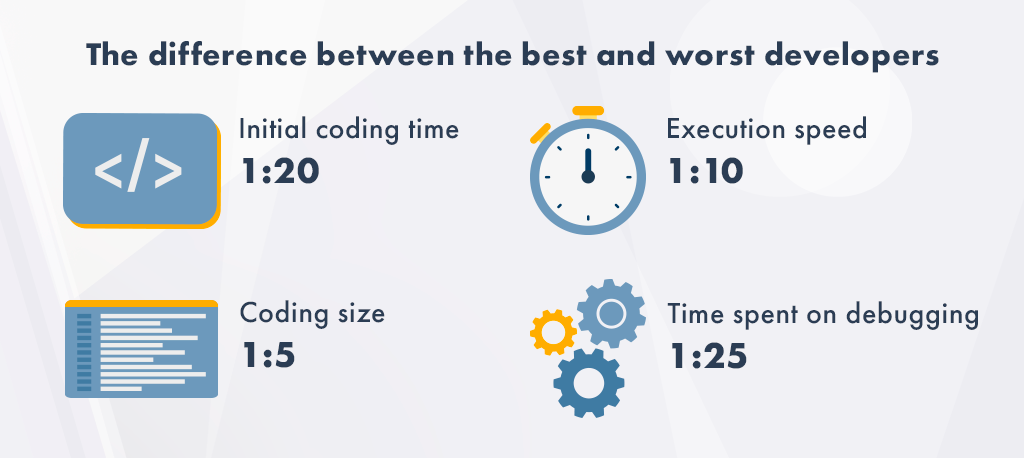
As you can see, researchers found that the difference in coding time between best and worst developers can be up to 20 times, execution speed can be ten times slower in the less talented, etc.
So, what can you do to ensure enough talented people are on your team?

Get unreal data to fix real issues in your app & web.
One of the things is investing more effort in testing their skills before hiring them.
For instance, TestGorilla can be a beneficial tool with its wide range of specialized tests for various programming languages, positions, or skill levels.
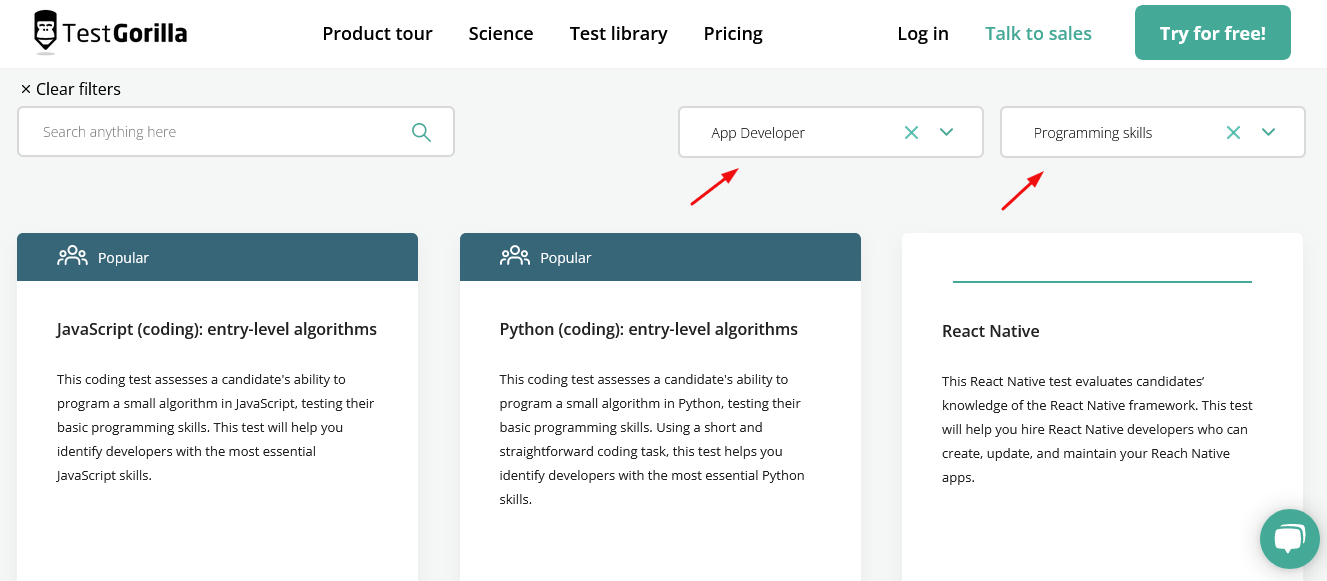
For instance, above, you can see how we chose a job role and a test type, and we got tests for JavaScript, Python, React Native, etc.
Comprehensive testing can help you with assessments, but if you’re even more ambitious about creating a talent-mining process, you can set up an internship.
That’s what Redbubble, an online marketplace for independent artists, did.

As Tom Sommer, their Director of Engineering, described, the interns had a full spectrum of experiences in the company, like any other developer that works there full-time.
They have mentors and lots of support they need, but at the end of the 12-week program, they’re hired only if they show a certain level of improvement.
The point of the program is to provide young developers with team experience, learning opportunities, and support and see if their talent will push them to succeed.
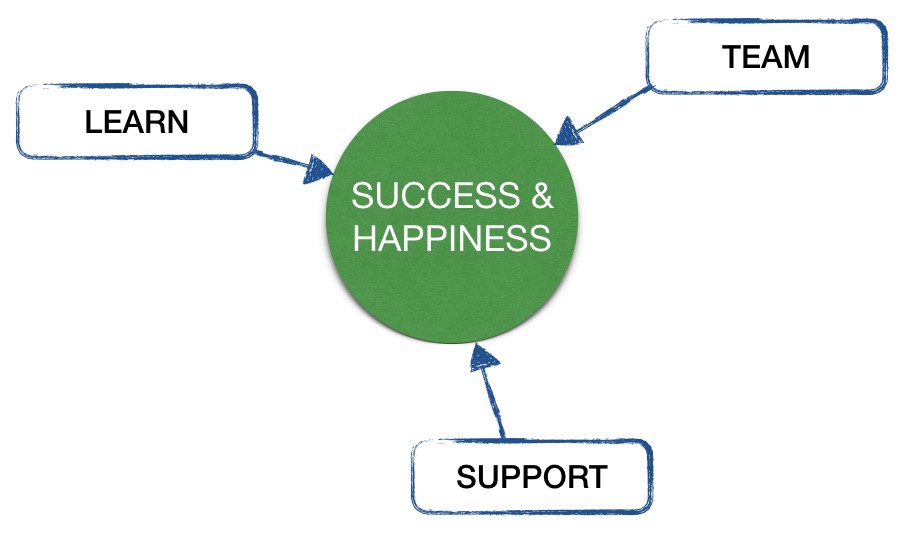
Recruiting talented developers can be challenging, but it isn’t impossible.
Success will be inevitable if you build a structured approach to recognize them and bring them to your team.
Managing dispersed teams
It’s not unusual for software developers to work remotely. That was true before, but even more recently, with the shift to remote work in many industries.
According to data from Terminal, in 2022, 61% of software engineers work entirely remotely.
If you add to that the 14% that work remotely over 50% of the time, you get that, on average, over 7 in 10 developers work from home.
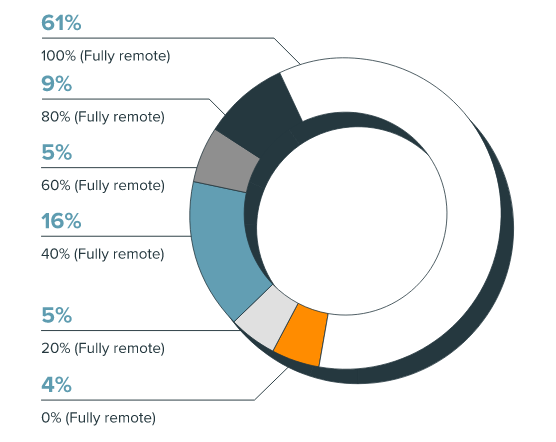
And while it can be convenient for employees to avoid commuting and be in the comfort of their homes, the situation can be challenging for leaders of those remote teams.
Even the tasks managers take for granted when the team works in the office can be demanding. For example, overseeing developers’ work isn’t as simple as stopping by at their desks.
However, software tools can help you track everything you need.
For instance, Asana is a popular tool for project management, organizing tasks, and other responsibilities you might have during a project.
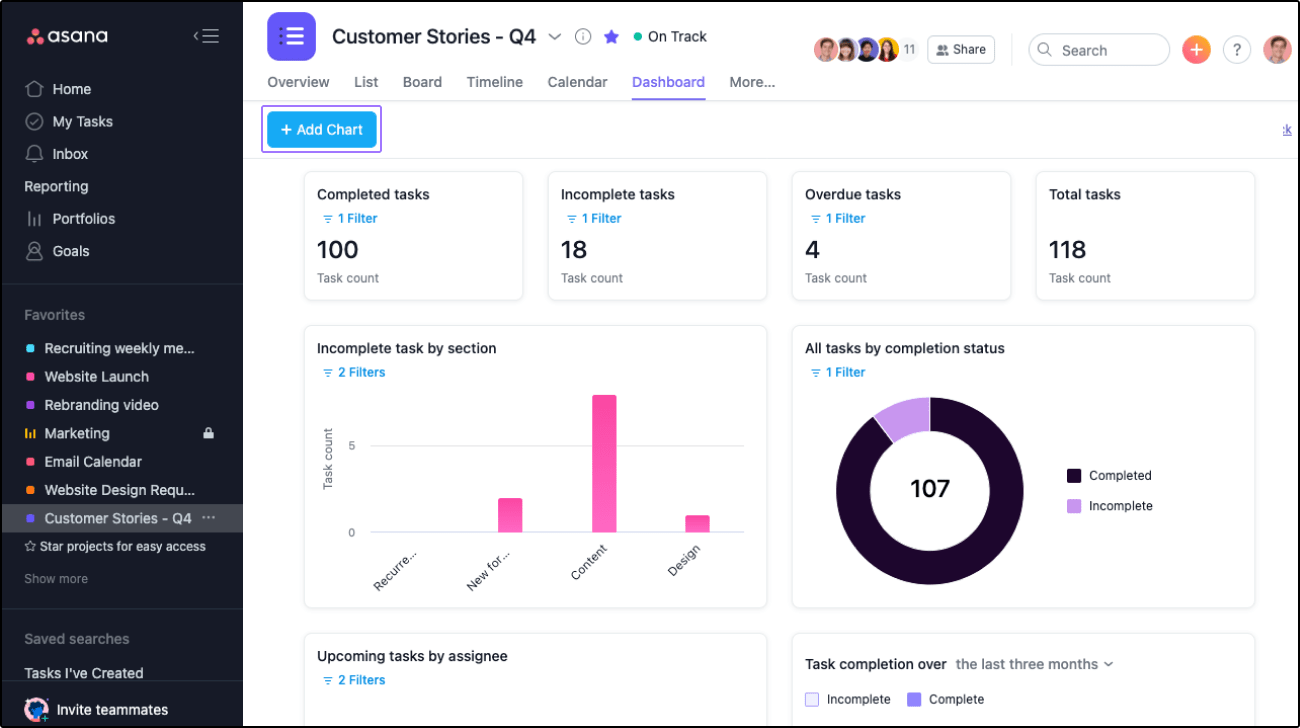
And if you prefer something that allows you to quickly check on everyone’s progress without sifting through dozens of features, there are solutions for that, as well.
Timely is a simple tool that keeps track of working hours, workload, and activity across the team.

Yummygum, a web design studio, uses Timely to plan, review project performance, and optimize processes, as their co-founder Vince Schwidder explained.
Furthermore, as a manager, he can see what his team is working on at any given moment.
But, overseeing a remote team isn’t the only challenge. Remote teams can lack the bonds and relationships formed when people work in the same space.
To counter that, it’s helpful to get the team together in non-work-related activities occasionally.
At Relevant Software, they have experience with that.

Above, you can see their developers in a VR quest room, one of the team-building activities the company organizes for them, as Anna Dziuba explains.
“Some of our favorite informal team-building activities are laser tag, VR quests, family lunches, partying together, skiing, hiking, etc.”
Dispersed teams can be a challenge to manage.
However, suppose you find ways to bring as many advantages of working in the office to them while simultaneously ensuring that you have enough control.
In that case, you can tackle that challenge successfully.
Assembling the perfect team
When assembling a team, you should strive to strike a balance that can facilitate the highest productivity and the best results.
A foundation from which you can start creating your team can combine more experienced, senior developers and younger, junior developers.
As Eric Elliot, developer and author, explains, senior mentors have a deep understanding of application architecture and productivity and can teach that to others.
On the other hand, junior developers develop features and work under the guidance of senior developers.
According to Petro Kovalchuk, here’s what you should look for when looking for members of your perfect team:

As you can see, senior developers are great for providing experience and reliable skills, and junior developers for strengthening the team’s potential.
However, some experts, including the mentioned Elliot, point out that you shouldn’t forget to include mid-level developers as a part of your team.
For instance, Cliff White, Vice President of Engineering at Cover, argues that mid-level developers, who have five to seven years of experience, take the pressure of seniors and can assist them with crucial tasks.

As you can see, he proposes a pyramidal structure for your perfect team, where junior developers make up the base.
That can look something like this:
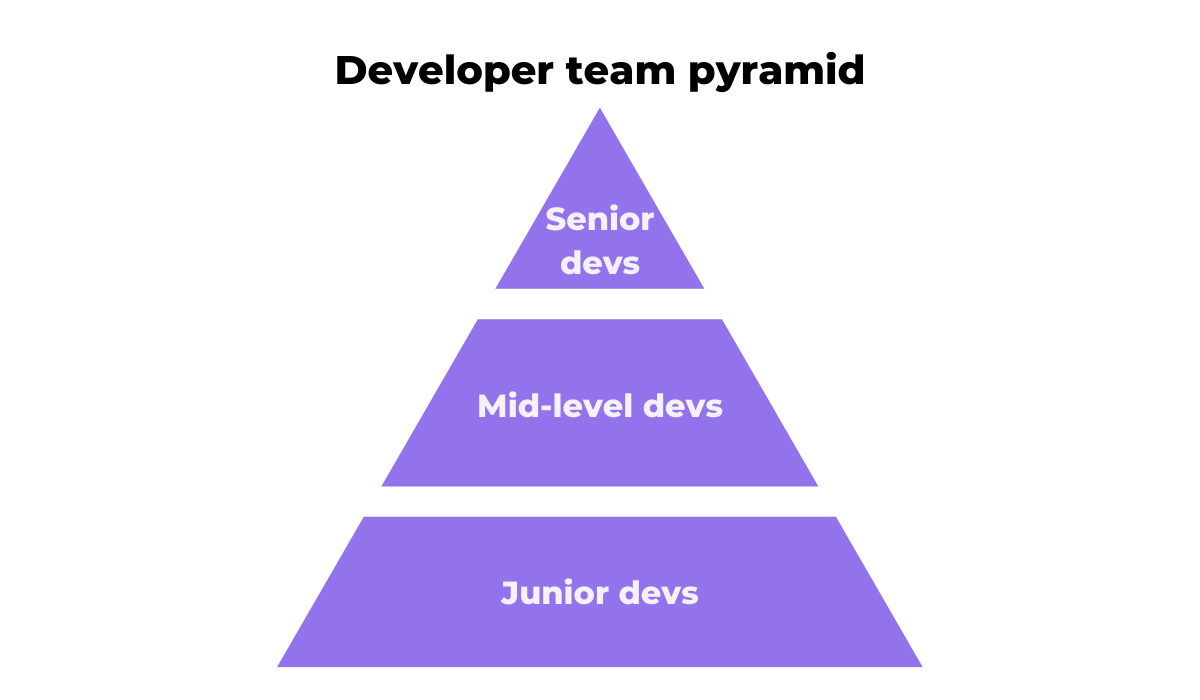
To make the most out of a structure like that, you should utilize all of its advantages, which means imprinting the senior developers’ knowledge on younger teammates.
A good way to ensure that is to have a buddy system. Eric Brechner explains that it can be any arrangement, as long as the experienced and younger developers work together.
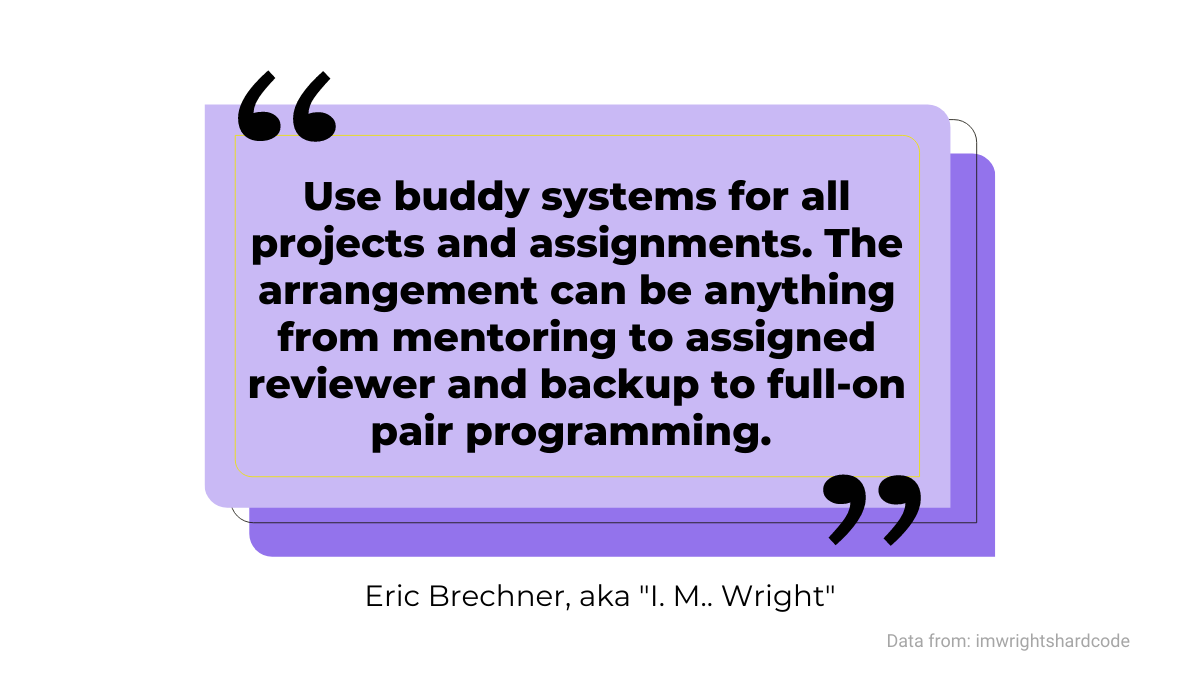
Whether you arrange pair programming sessions or facilitate code reviews, that’s your preference.
The point is that you assemble your team so you can take full advantage of every developer’s potential and skills.
And developers can reap the benefits as well, as you can see from the experience of a former Amazon developer below.
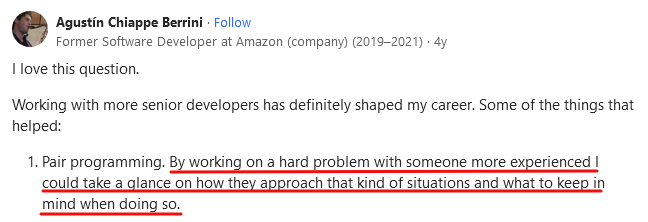
A perfect team is an elusive concept, and you might feel like you can never achieve it—and that might be true.
However, if you assemble your team the right way, you can certainly get close to it by carefully combining the skills and experience of your developers.
Handling generational differences
If you follow the advice about assembling a perfect team from the previous section, you’ll likely work with some experienced developers and some younger ones.
According to data from the Stack Overflow 2021 survey, the age gap can be considerable.
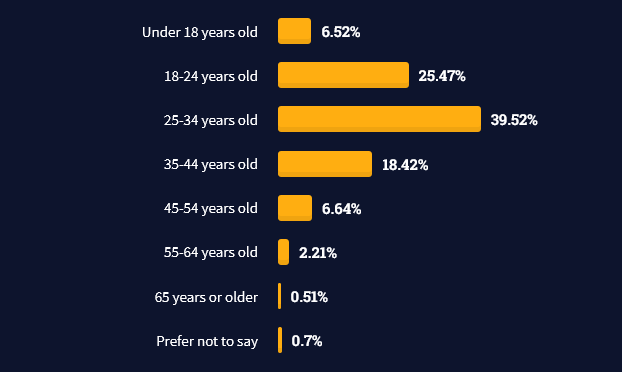
As you can see, there is a significant chance that you have, for example, a 19-year-old developer working alongside a 34-year-old one.
Although they are all software developers, they might have different work habits, practices, expectations from the job and colleagues, and even a whole software development philosophy.
For instance, Chris Fox is a software developer with over 20 years of experience in various companies, including Microsoft.
It’s apparent from the quote below that he isn’t a fan of modern methodologies and frameworks.

Also, he has certain expectations from a job that stems from his days as a young developer—developers should work alone, unit testing and meetings are pointless, methodologies like Agile and Scrum are only adding extra layers of work, and when he tried pair programming, he resigned the next morning.
Whether his opinions are valid or not is not the issue. An issue for a team leader can be someone unwilling to adapt.
On the other hand, some experienced developers have a different mindset, like this one from one of the Dev.to threads:
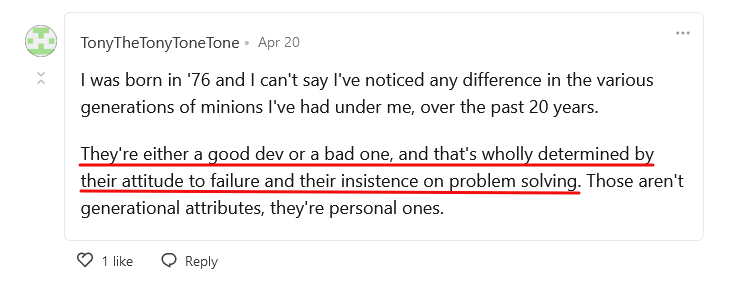
Developers from younger generations are mainly used to working in agile environments, larger teams, and with broader responsibilities that require more than writing code.
For instance, here’s what an experienced CTO, Ofer Garnett, thinks of developers from the millennial generation:
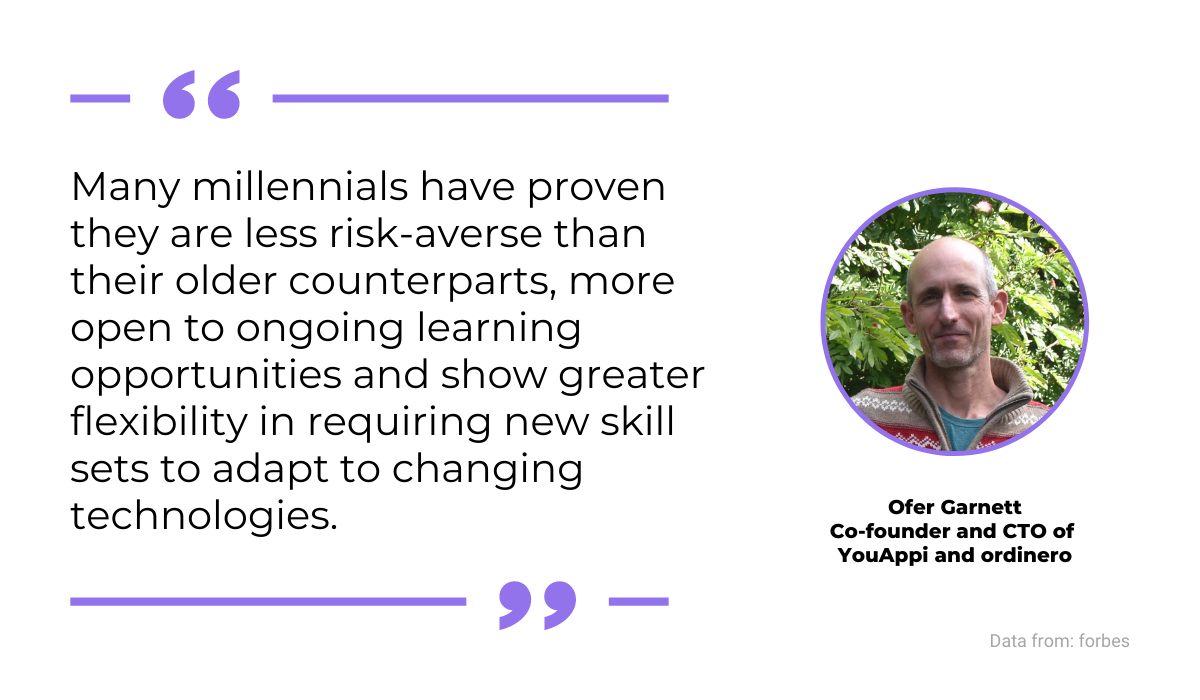
Whatever ratio of older to younger developers you have in your team, you should consider simplifying the adjustment to a team culture for them.
You can accomplish that with a culture buddy, someone who’s on the team longer and can show them the non-technical side of work.
At Pinterest, they do this right from the onboarding phase.

You can read more about their program in the article from Cindy Xinyi Zhang, their Data Scientist.
In short, a culture buddy can help developers adapt to the team, whether they’re more experienced or younger.
The willingness to adapt is undoubtedly one of the most important traits in a developer, no matter the generation they belong to.
Handling differences will be much easier if you have flexible teammates.
Avoiding micromanagement
One of the challenges in managing software development teams is not to manage them too much—in other words, give them a degree of freedom to complete their tasks on their terms.
Generally speaking, developers value their autonomy—a big part of the job is to use skills creatively, find solutions and innovate. It’s hard to do that when a manager is hovering over them.
Furthermore, micromanaging can be detrimental to the leader’s well-being.
According to data from a Global Leadership Forecast 2021 by DDI, 60% of leaders feel used up at the end of the day, which can lead to burnout.

And since leaders of software development teams are developers themselves, they have the additional risk of developer burnout.
So, if you combine the feeling of exhaustion at the end of the day with data from Haystack that indicates that 21% of developers feel burnt out “to a great extent” and 34% of them feel that “to a moderate extent,” it’s clear that software development leaders should take caution.

Therefore, you should do what you can to overcome the urge to micromanage and to do too much work yourself.
To do that, you should put more trust in your team.
Werner Vogels, Vice President and CTO of Amazon, coined the phrase You build it, you run it in a 2006 interview to explain the company’s turn to DevOps methodology.

In a nutshell, that means that developers are responsible both for the building, operating, and supporting the system.
A streaming giant Netflix adopted that approach also. Their developers have a lot of autonomy but also a lot of responsibility in taking care of the full software life cycle.
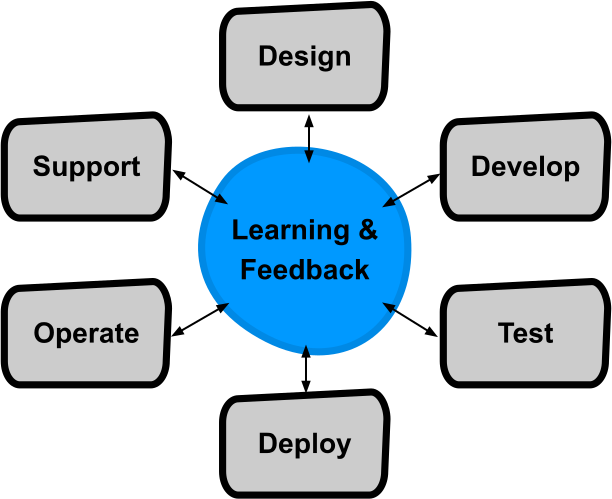
If you choose to give autonomy to your team and avoid micromanagement, not only will you relieve yourself of too much work, you’ll most likely improve the team’s results.
That’s what experience in leading teams showed to Nick Tune, a Principal Consultant at Empathy Software.
“A decade of experience has shown me that the top teams who are pushing the barriers of innovation, speed, and quality are highly autonomous.”
Therefore, overcoming the challenge of micromanaging your team is beneficial on all fronts—for you, the team, and the results.
Keeping communication effective
Effective communication is essential if you want your team to achieve the best results possible. That’s why it’s vital to overcome the communication challenges that can arise.
With software development being so complex, the ideas and concepts are also like that. Being able to communicate them clearly can make a significant difference.
However, you might be wrong if you think rounding up your whole team for meetings to convey those messages is the most effective way.
According to Paul Graham, that’s rarely effective for developers.

The different schedule he mentions is the maker’s schedule. Developers are makers, requiring longer periods of time to bring their idea to life with code.
On the other hand, managers are on the manager’s schedule, often divided into blocks of an hour or even less.
That’s why meetings aren’t effective for communication with developers—they interrupt their schedule and mess with their focus and flow.
An alternative can be to cluster meetings together. For example, Dan Lines, Co-founder and COO at LinearB regards that as an effective solution.

Notice how his meetings are in clusters throughout the week.
That allows his developers to have long stretches of uninterrupted time for thinking and creating without constantly running to meetings.
Having a good communication tool can also help with effective communication, especially if you reduce the number of meetings with your developers.
For example, SurveyMonkey, an online feedback platform, uses Slack for effective communication across the organization.

According to their former president Tom Hale, they significantly shortened their meetings because major updates were sent through Slack channels—dedicated spaces for communication that you can organize around a project, team, topic, or any other criteria.
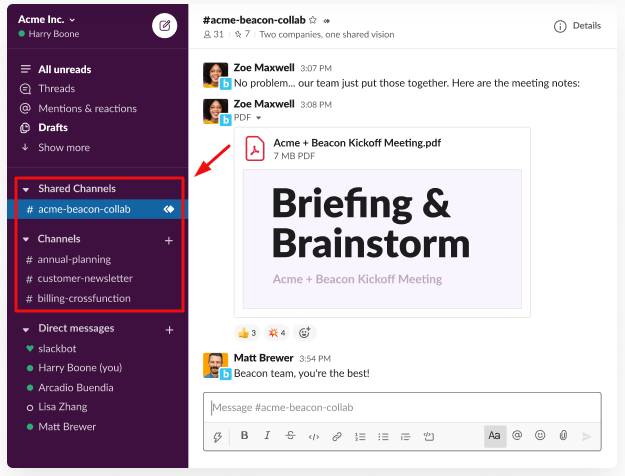
Also, they didn’t need to rely on emails as much—almost 200 email distribution lists were replaced with communication on Slack.
Finding ways to keep communication effective is vital for your team’s productivity.
Using tools and managing schedules can make a big difference, so you should consider reevaluating your systems.
Conclusion
Managing a software development team requires knowledge, skills, patience, and good judgment.
That’s only a part of what’s required to be a truly exceptional leader. And while you’re on the path to becoming one, you must overcome common challenges.
As we examined in this article, recruiting talented people, managing dispersed teams, striking a perfect balance when assembling a team, handling generational differences among developers, refraining from micromanagement, and communicating effectively are areas you should emphasize.
If you do that, managing developers will be a joy, not a burden.




